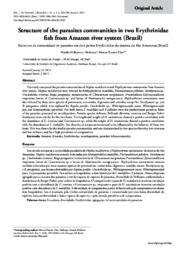Structure of the parasites communities in two Erythrinidae fish from Amazon river system (Brazil).
Structure of the parasites communities in two Erythrinidae fish from Amazon river system (Brazil).
Author(s): ALCÂNTARA, N. M.; TAVARES-DIAS, M.
Summary: This study compared the parasite communities of Hoplias malabaricus and Hoplerythrinus unitaeniatus from Amazon river system. Hoplias malabaricus were infected by Ichthyophthirius multifiliis, Piscinoodinium pillulare, Tetrahymena sp., Urocleidoides eremitus, Braga patagonica, metacercariae of Clinostomum marginatum, Procamallanus (Spirocamallanus) inopinatus, larvae of Contracaecum sp. and larvae of Nomimoscolex matogrossensis. Hoplerythrinus unitaeniatus were also infected by these same species of protozoans, nematodes, digeneans and cestodes, except for Tetrahymena sp. and B. patagonica, which were replaced by Argulus pestifer, Urocleidoides sp., Whittingtonocotyle caetei, Whittingtonocotyle jeju and Gorytocephalus spectabilis. For both hosts, I. multifiliis and P. pillulare were the predominant parasites. Most of the parasites presented an overdispersion. Parasite species richness, Brillouin diversity, evenness and Berger-Parker dominance were similar for the two hosts. The length and weight of H. malabaricus showed a positive correlation with the abundance of U. eremitus and Contracaecum sp., while the weight of H. unitaeniatus showed a positive correlation with the abundance of I. multifiliis. The diversity of ectoparasites seemed to be influenced by the behavior of these two hosts. This was shown by the similar parasite communities and was characterized by low species diversity, low evenness and low richness, and by a high prevalence of ectoparasites.
Publication year: 2015
Types of publication: Journal article
Unit: Embrapa Amapá
Observation
Some of Embrapa's publications are published as ePub files. To read them, use or download one of the following free software options to your computer or mobile device. Android: Google Play Books; IOS: iBooks; Windows and Linux: Calibre.
Access other publications
Access the Agricultural Research Database (BDPA) to consult Embrapa's full library collection and records.
Visit Embrapa Bookstore to purchase books and other publications sold by Embrapa.

